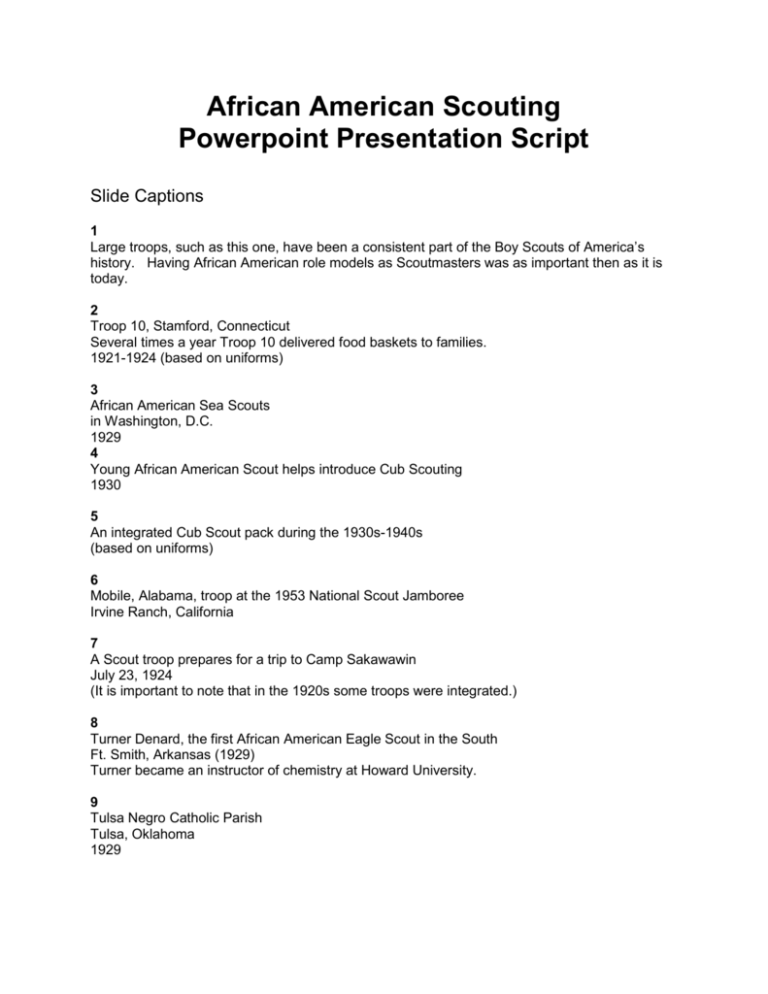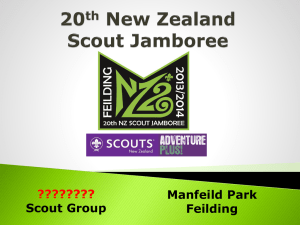Black History Month - Boy Scouts of America
advertisement

African American Scouting Powerpoint Presentation Script Slide Captions 1 Large troops, such as this one, have been a consistent part of the Boy Scouts of America’s history. Having African American role models as Scoutmasters was as important then as it is today. 2 Troop 10, Stamford, Connecticut Several times a year Troop 10 delivered food baskets to families. 1921-1924 (based on uniforms) 3 African American Sea Scouts in Washington, D.C. 1929 4 Young African American Scout helps introduce Cub Scouting 1930 5 An integrated Cub Scout pack during the 1930s-1940s (based on uniforms) 6 Mobile, Alabama, troop at the 1953 National Scout Jamboree Irvine Ranch, California 7 A Scout troop prepares for a trip to Camp Sakawawin July 23, 1924 (It is important to note that in the 1920s some troops were integrated.) 8 Turner Denard, the first African American Eagle Scout in the South Ft. Smith, Arkansas (1929) Turner became an instructor of chemistry at Howard University. 9 Tulsa Negro Catholic Parish Tulsa, Oklahoma 1929 Powerpoint Presentation Script, page 2 of 2 Facts for Scouts One of the earliest African American troops was chartered in 1911 in Elizabeth City, New Jersey. The first council to promote professional Boy Scout work for African American Scouts was in Louisville, Kentucky, in 1916. By the following year, four troops were organized with many more planned. Similar pilot programs were started in 1925 in Raleigh, North Carolina; Newport News, Virginia; and Port Arthur, Texas. By the end of 1927, African American troops existed in each of the southern states. The council in Chicago, Illinois, was the first to hire a full-time African American field executive. African American Scouts from every region in the country attended the first national jamboree in Washington in 1937. African American Scouts attended the 1950 world jamboree in France. Facts for Professional Scouters In 1931, the first Silver Beavers awarded to African American Scouters were given to council volunteers in Dayton, Ohio, and Louisville, Kentucky. In 1937, 10 African American professionals graduated from the national training school. In 1950, the Silver Antelope was awarded to an African American, Dr. E. B. Evans of Texas. In 1951, Dr. Ralph Bunch received the Silver Buffalo at the National Annual Meeting in Chicago. In 1953, Ebony magazine did an extensive write-up on the third National Scout Jamboree, where more than 1,000 African American Scouts were in attendance. In 1954, local councils discontinued the practice of keeping records based on racial identification. Interesting Stories In Fort Worth, Texas, a 13-year-old African American Boy Scout found a lady’s pocketbook with more than $300 currency in it and returned the pocketbook. The boy simply declined the liberal reward offered by saying,” No madam, I am a Boy Scout and cannot take a tip for doing my duty.” —Taken from the 1929 Boy Scouts of America, National Annual Report. In Topeka, Kansas, Eagle candidate David Joe Sneden, 14, selected Simon Johnson to present his Eagle badge at a special troop Court of Honor. The two met two years earlier at a summer camp and became fast friends. This story is significant because it is the first record of an African American Scoutmaster giving the Eagle Scout challenge to a white child. —Taken from the annual bulletin of the 1953 Interracial Relationship Committee






